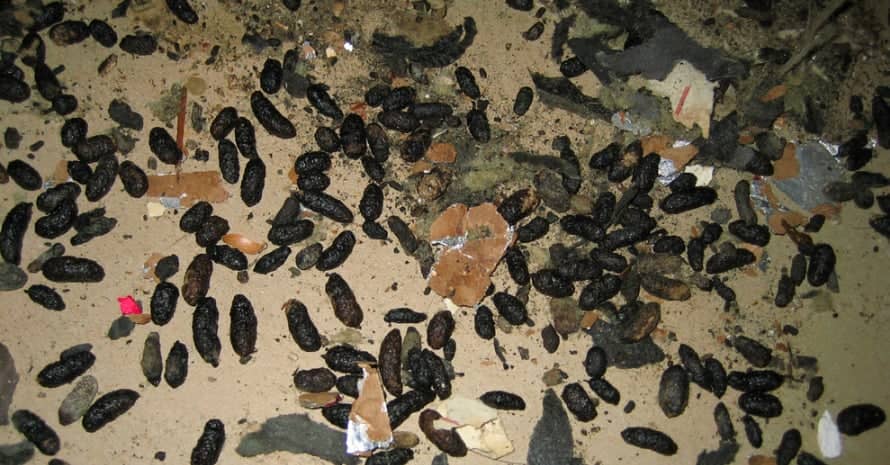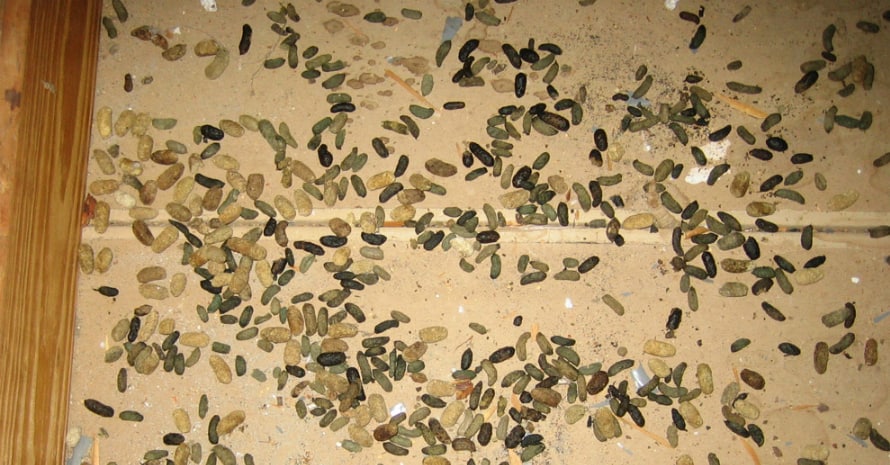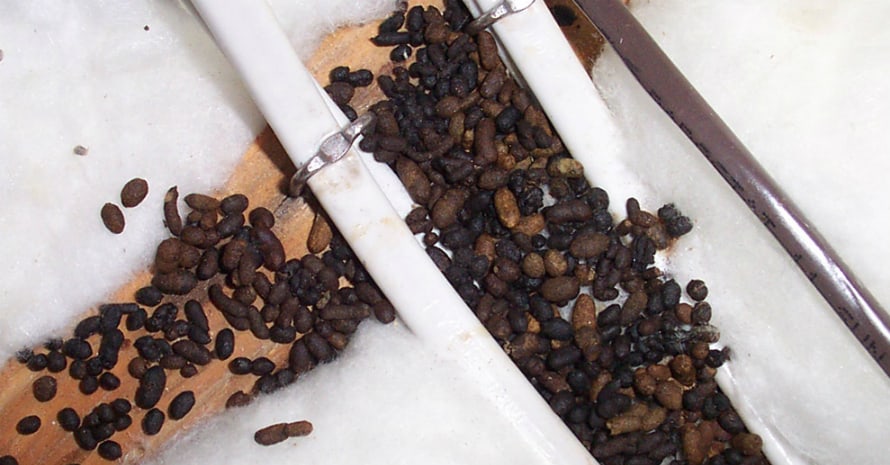If you’ve detected a squirrel infestation in your attic recently, be sure that there are loads of squirrel turds around. It could be an ordinary problem, but squirrels are carriers of various diseases, and many of them are transmitted through squirrel poop and urine.
This means that you should get ready not only to deal with the infestation but also to get rid of feces in a safe way.
Prepare goggles, face mask (preferably a respirator), gloves, and hand overalls (or a long-sleeve shirt) to avoid any type of contact with spores and bacteria.
That’s a real biological hazard, so your approach must be serious. But the first thing you should do is read my guide to deal with the problem properly.
Squirrel Feces: Easy Extermination Guide

In this guide, I covered all the important aspects of the problem. Read it to learn how to identify infestations and squirrel droppings and clean the contaminated areas. Don’t forget about safety rules, and learn how to manage squirrels to avoid reinfestations.
What does squirrel poop look like?
Being able to tell squirrel scat from feces of other rodents is a key factor in deciding on which control method you have to apply. Unlike light brown, reddish, or rusty rat scat, squirrel poop is usually dark brown and black. However, it gets lighter over time, which makes it harder to distinguish by color.
The diet of these rodents differs a lot, so the shape of fecal pellets is also different. While rat scat is usually quite narrow and has pointed ends, squirrels make thicker pellets with rounded ends.
Squirrel pellets are usually about 3/8 inches long and about 1/8 inch in diameter.
They are a bit longer and have a thickening point in the center. I recommend you to download a few squirrel poop images to simplify identification or use pictures of squirrel poop from the article. Another sign that the feces are left by squirrels is their number. Other rodents leave fewer feces around a single site.
Squirrel poop diseases

Similar to other rodents, squirrels transmit a number of diseases through feces. The most dangerous of them is leptospirosis. It can be spread by both feces and urine and lives up to 180 days in a contaminated area.
Intoxication effects are usually quite mild but can also lead to lethal respiratory problems if you are in a risk group. Another dangerous and common disease transmitted by squirrels is salmonella.
It may cause heavy diarrhea and vomiting, but lethality is very low. Besides, contaminated sites can be infested with ticks and fleas that travel on squirrel bodies. They can easily get onto your clothes and infest your home, so the best solution is to dispose of the clothes you wore or take it to the dry cleaner asap.

How to clean squirrel feces?
When you find a contaminated site, you have to clean it thoroughly. Squirrels leave quite a lot of feces, so the best way to gather them is to use a powerful filter vacuum that uses disposable bags as storage.
If you see scat that stack to the floor, use a chisel knife to cut them off. When the feces are removed, you have to dispose of them immediately to avoid contamination of other spots around the house.
But what to do with urine spots and invisible leftovers? The smell of pheromones will keep attracting squirrels and other rodents to the place, so it’s important to use a disinfectant spray throughout the entire place and make the place safe again.
After that, find all the possible entry points to the attic or cavity and seal them firmly. Otherwise, the rodents will get back to the site as soon as they find it attractive again.
[su_note note_color=”#e5e2d4″]Recommended squirrel repellents [/su_note]
How to identify an infestation?
Squirrel infestation isn’t too difficult to identify as these animals don’t try to be stealth at all. When the infestation takes place, you may hear strange noises, such as scampering and jumping in the attic, scratching in wall cavities, or down the chimney. The next sign is a squirrel scat here and there. You already know how to identify it, so it won’t be a problem.
Other signs include:
- damaged entry points – squirrels can chew through materials (even through metal) to get inside structures;
- interior damage – squirrels that get into your attic, will tear up insulation, shred duct works, and, what’s more dangerous, chew the wiring if they find it;
- Squirrel footprints – it’s quite easy to see them on snow, dust, and mud. If you see tracks around your yard, it’s time to inspect the attic;
- Strange smell – sometimes, squirrels get stuck and die inside structures. Their corpses cause an awful smell that won’t go unnoticed.
FAQ on Squirrel Poop

Here are some brief answers to the most frequent questions that my customers and readers ask. Skim them through to have a better understanding of the problem and feel more fluent.
[su_note note_color=”#e5e2d4″]Recommended squirrel traps [/su_note]
Where do squirrels poop?
Have you ever seen how squirrels go to the bathroom? Apparently not! Actually, they do it in a bit surprising places. I usually find squirrel poop near the feeding, inside their nests, in wall cavities, and in the attics. They tend to organize ‘bathrooms’ in particular places and use these places repeatedly. That’s pretty clever and makes removing the feces easier for us.
Do I need to worry about squirrel poop where my children play?
Given that squirrel scat can transmit dangerous diseases, you shouldn’t let your children play where squirrels poop. Stop the infestation, remove scat, and sanitize the area before letting your children and pets inside.
How long is squirrel feces dangerous?
Squirrel droppings are soft only during the first hours, but when they dry, the risk of inhaling droplets rises. This means that the feces are dangerous all the time. Even though infections like salmonella last only up to 7 days, you never know how old each pallet is, so precautions are necessary.
Good Luck!
With all the knowledge you have now, you can go and solve the problem once and for all without any risk. Although squirrel excrement is quite dangerous and hard to remove, you can prevent reinfestations in your attic quite easily and for a very long time.
Is it the first time you face a squirrel infestation? If not, tell me what methods you applied, and we’ll see if there was a mistake that led to a reinfestation. If you have any questions left after reading, you’re welcome to ask me via the comments section. For more guides on dealing with animal poop, stay tuned to my blog.
References:
- Leptospirosis (U.S. Department of Health and Human Services):
https://cybercemetery.unt.edu/archive/oilspill/20120928175206/http://www.nlm.nih.gov/medlineplus/ency/article/001376.htm - How dangerous is salmonella? (The Ohio State University by Liz Weinandy, RD):
https://wexnermedical.osu.edu/blog/how-dangerous-is-salmonella

